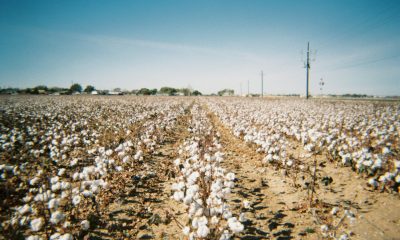Featured
Cocoa Buyers Can Afford to Wait for Lower Prices to Develop
New York and London closed the week with moderate losses after trading much lower in the middle of the week. Cocoa prices are still relatively high given the fundamentals of good production and questionable demand. Ideas of big production and uncertain demand are still around but reports from Africa indicate that demand has improved lately.
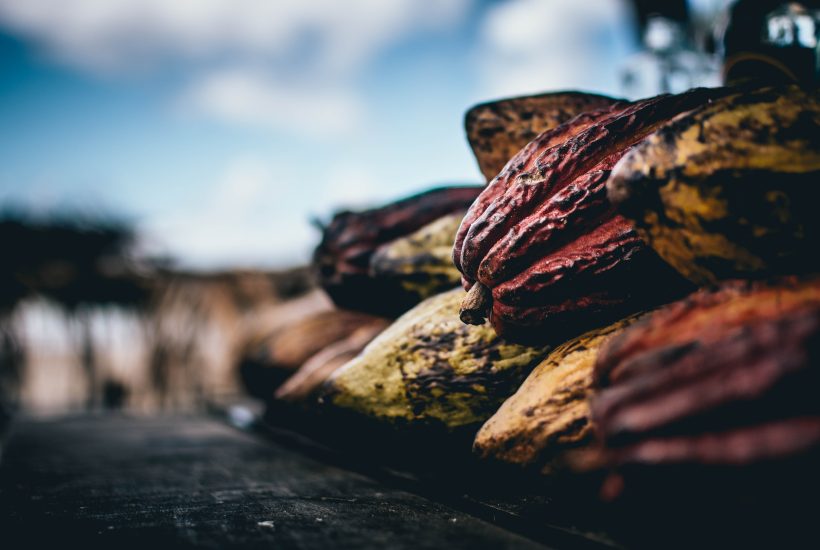
Wheat: Wheat markets were lower last week on weak demand and ideas that weak demand can continue due in part to a stronger US Dollar. There was news that Russia has sent a letter to the UN demanding changes in the export agreement in the Black Sea with Ukraine. Russia is looking to export more and wants Ukraine to export less and to only countries it defines as poor. USDA cut demand more than the trade had expected and left ending stocks below last month but higher than trade expectations. Ukraine apparently bombed a bridge connecting Russia and Crimea over the weekend and Russia retaliated on Monday by bombing cities in Ukraine including Kiev. Russia now appears to be losing the war and could do something rash to try to hold things together. The demand for US Wheat still needs to show up and right now there is no demand news to help support futures.. Europe is too hot and dry and the US central and southern Great Plains have also been too hot and dry. Planting and initial emergence could be affected. Dry weather has affected the Indian production as well.
Weekly Chicago Soft Red Winter Wheat Futures
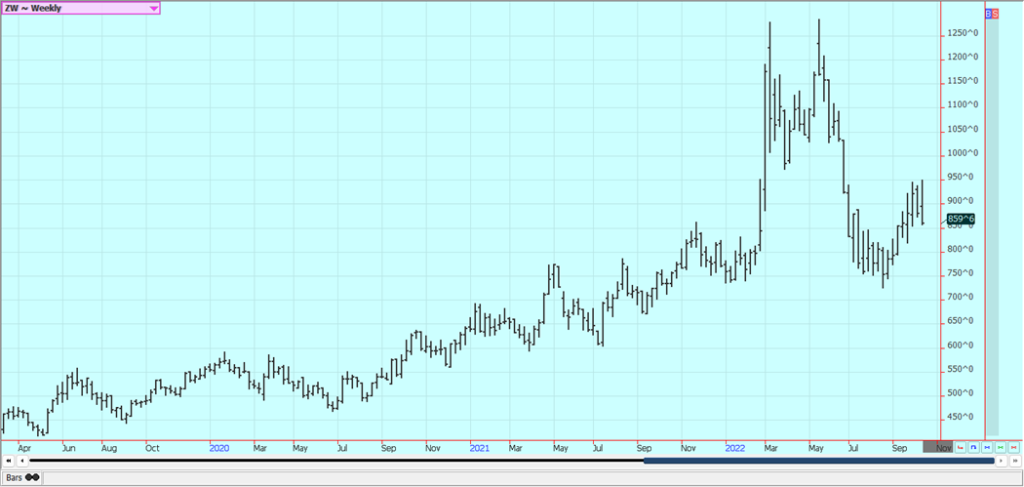
Weekly Chicago Hard Red Winter Wheat Futures

Weekly Minneapolis Hard Red Spring Wheat Futures
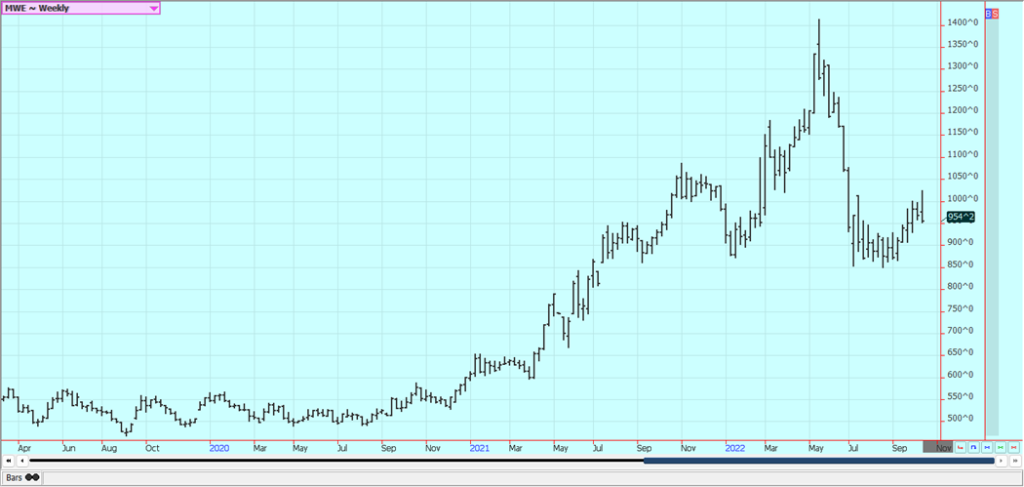
Corn: Corn closed a little higher last week in reaction to the USDA reports that showed ending stocks above trade expectations but less than a month ago. Corn also found support from the Ukraine-Russia news as Russia is now asking for major changes in the deal to permit esports from Black Sea ports Prices were hurt on ideas of weak demand. US production was cut in line with trade expectations but demand was cut more and ending stocks were higher than trade expectations, although below last month. The Mississippi river is low due to the dry conditions seen in most of the central parts of the US and there are no forecasts for an improvement soon. Barge traffic has been reduced. The cash market has been strong at the Gulf but weak in the Midwest river areas due to the low river levels. The demand side will need to be watched as Corn demand needs to hold to keep lower ending stocks estimates in play. There are increasing concerns about demand with the Chinese economic problems caused by the lockdowns creating the possibility of less demand as South America has much better crops this year to compete with the US for sales. Export demand in general has been slow so far this year.
Weekly Corn Futures
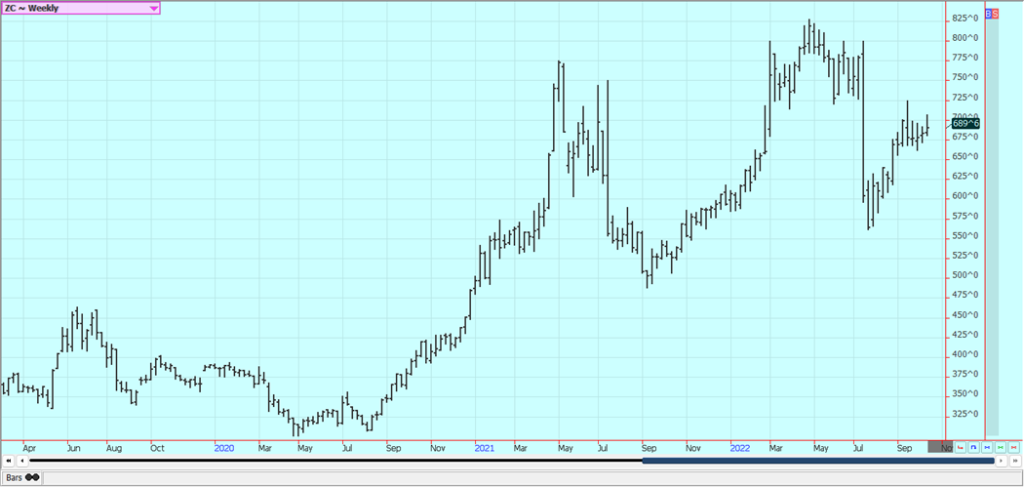
Weekly Oats Futures

Soybeans and Soybean Meal: Soybeans and Soybean Meal were moderately higher last week and Soybean Oil was a little lower. The market was not strong considering that there have been export sales of 1.5 million tons of Soybeans in the last few days as the trade is worried about longer term factors. USDA reduced production and demand and ending stocks were left unchanged. The trade had expected increased ending stocks due to less demand. The US will still harvest plenty of Soybeans in the next few weeks and ideas that Brazil is off to a very good start kept the rally in check and futures closed with only moderate gains after a sharp rally above 1400 when the report was released. The Mississippi river is low due to the dry conditions seen in most of the central parts of the US and there are no forecasts for an improvement soon. Barge traffic has been reduced but the Coast Guard said yesterday that barge traffic is permitted in the river. The trade worried about international weather and supply. Demand remains an issue for the market to contend with. The trade is worried about demand due to a lack of Chinese interest caused by the Covid lockdowns there and in part by the stronger US Dollar. Brazil is still offering and South America as a whole are expected to produce a very big crop later this year for harvest next Spring. However, a third year of La Nina as predicted by meteorologists could cut the production potential. US production ideas remain strong after mostly good weather in August. Basis levels are still strong in the Midwest. There are still Chinese lockdowns and there are fears that China has been importing less as a result.
Weekly Chicago Soybeans Futures:
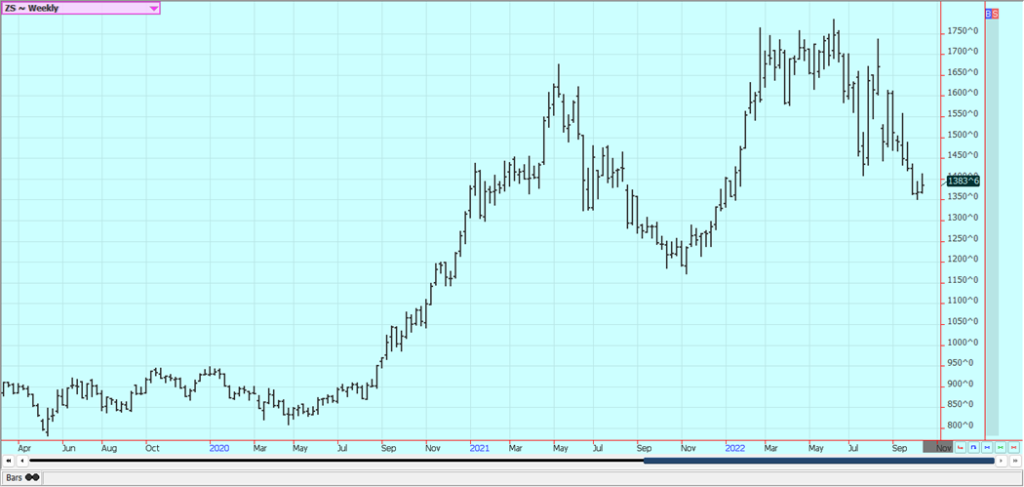
Weekly Chicago Soybean Meal Futures
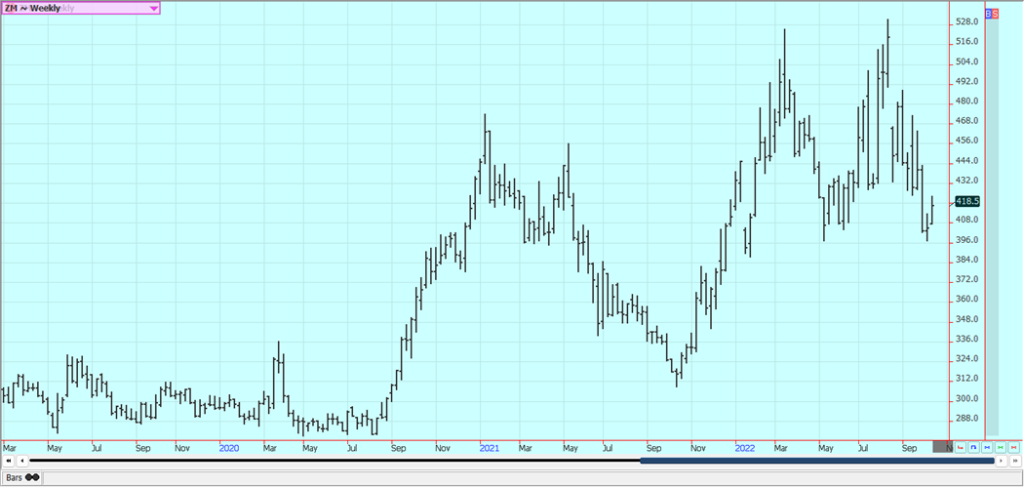
Rice: Rice was a little lower last week in consolidation trading and as the harvest pressure continued. The weekly charts show that futures are trying to break through some big support areas but those areas are holding for now. USDA left its production estimates unchanged in its reports last week and cut export demand by 2.0 million cwt for an increase in ending stocks levels. The data did not show any major changes so futures were able to hold and close on a firm note. Harvest progress is now rapid in Arkansas, the largest Rice producing state, and yields and quality are reported to be very strong. Mississippi is also at harvest with much more mixed results. Some producers are getting done with harvesting in Texas as well as in southern Louisiana Yield reports have been generally good in Louisiana and quality reports are generally good. Yield and quality have been up and down in Texas.
Weekly Chicago Rice Futures

Palm Oil and Vegetable Oils: Palm Oil was higher last week despite bearish stocks data from MPOB as futures prices recovered from very oversold levels. Ideas are that supply and production will be strong, but demand ideas are now weakening and the market will continue to look to the private data for clues on demand and the direction of the futures market. Export data has been strong this month from the private sources and MPOB reported improved demand last month. Production was also higher and ending stocks were up more than 10% to 2.315 million tons. Canola was a little lower last week along with Soybean Oil and partly in reaction to the USDA reports. The Canola harvest is active and starting to wind down in some areas. Some of the early week rally came on continued cash market strength before the harvest. The Canola growing conditions are much improved and production estimates are higher for the year.
Weekly Malaysian Palm Oil Futures
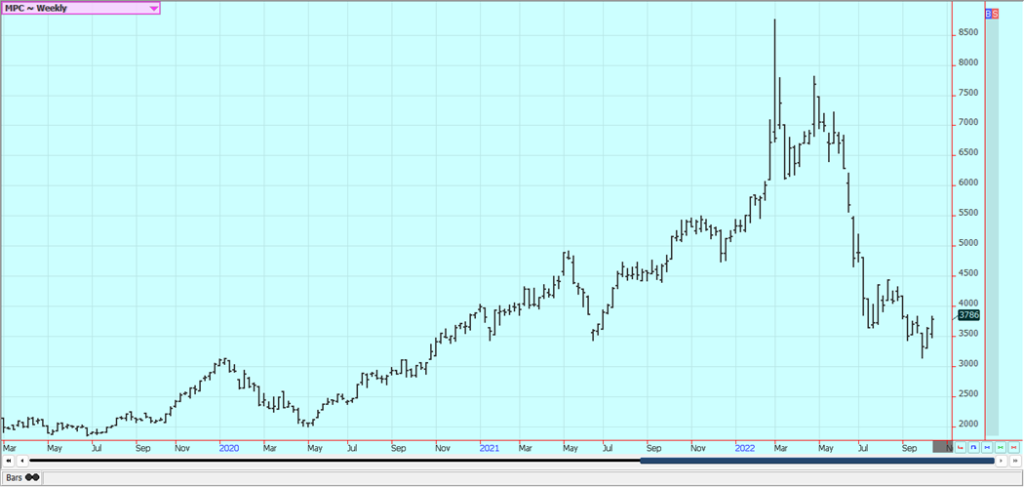
Weekly Chicago Soybean Oil Futures
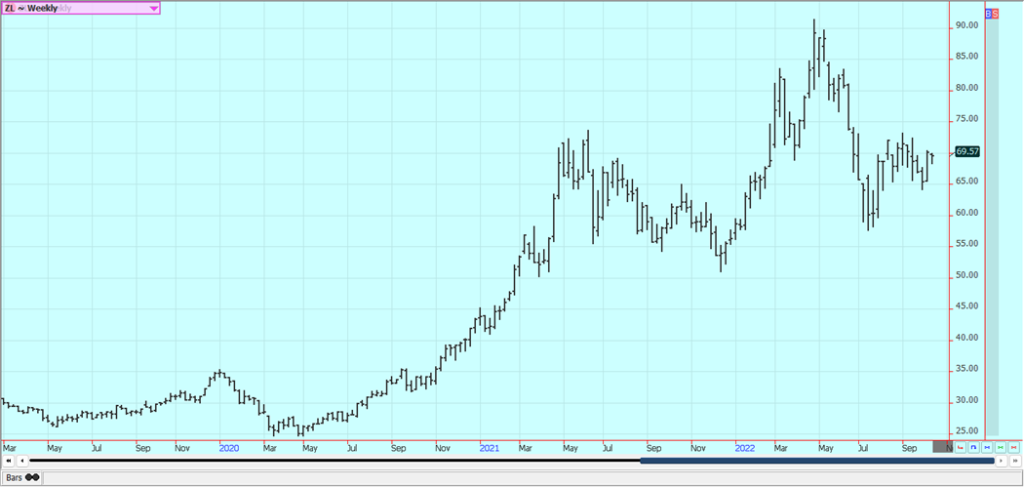
Weekly Canola Futures:
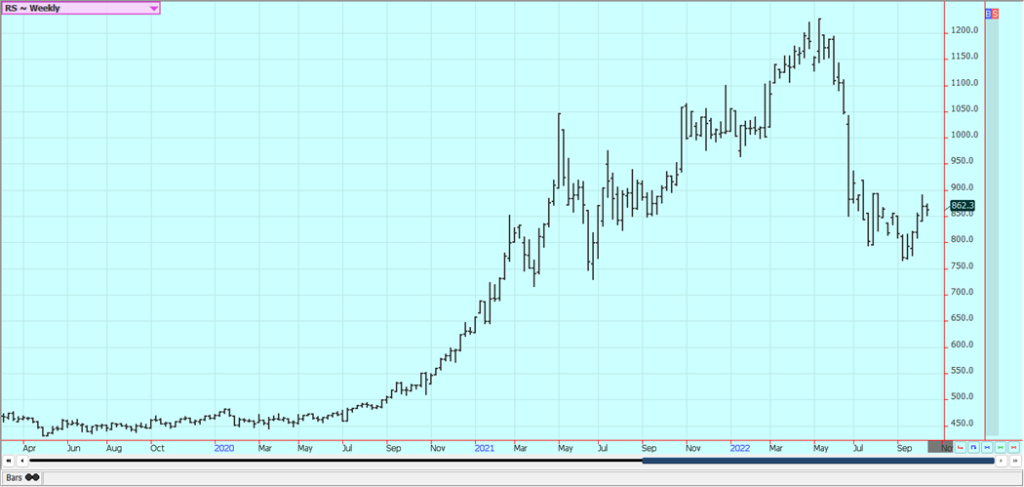
Cotton: Cotton was a little lower in range trading last week and remains lower in response to the USDA estimates that showed slightly less production and much less demand for US Cotton. Traders are worried about a global recession and demand in that recession and also about Chinese demand due to the lockdowns there. Production is very short. The harvest is appearing in the market, and the market has responded to it with sideways to lower prices. The trade is still worried about demand moving forward due to recession fears and Chinese lockdowns but is also worried about total US production potential. It is possible that the continued Chinese lockdowns will continue to hurt demand for imported Cotton for that country and that a weaker economy in the west will hurt demand from the rest of the world.
Weekly US Cotton Futures

Frozen Concentrated Orange Juice and Citrus: FCOJ was a little higher in range trading last week in response to the latest USDA Florida production estimates that showed that the major hurricane that moved onshore Florida last week left extensive damage. Much of the damage is already factored into prices, but the market is holding at elevated levels. USDA estimated Florida production at 28 million boxes, down 32% from last year and a dramatic drop in production potential. Early and mid production dropped 40% while Val3encia production was 25% lower. The weather remains generally good for production around the world for the next crop but not for production areas in Florida that have been impacted in a big way by the storm. Brazil has some rain and conditions are rated good. More showers are in the forecast for the coming days. Florida damage is expected to be very big, with many trees lost as well as fruit lost. Mexican areas are showing mixed trends, with dry weather in some northern areas but better weather to the south.
Weekly FCOJ Futures
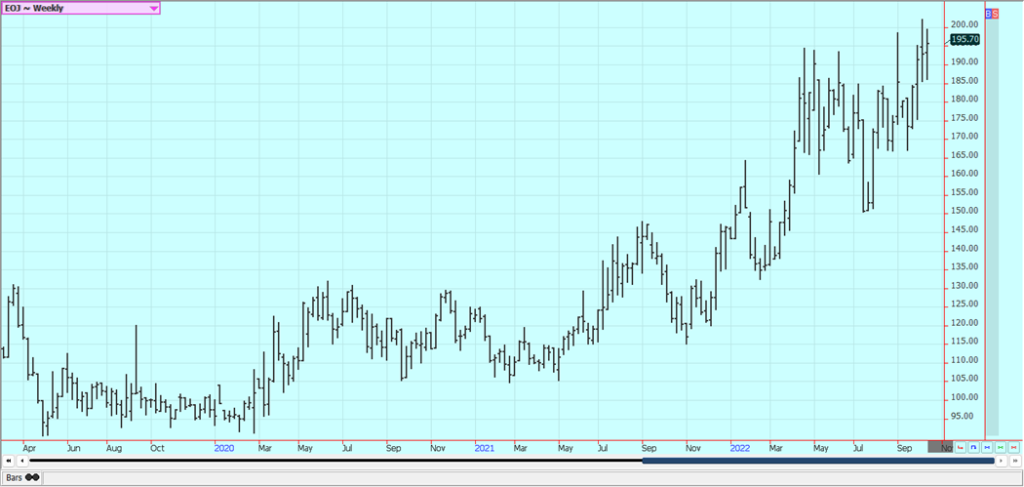
Coffee: New York and London closed lower again Friday and were much lower for the week in response to the latest export data from Cecafe in Brazil and on ideas and reports of improving growing conditions in Brazil. Trends are down on the daily and weekly charts for both markets but short term rallies are possible this week as the daily charts suggest oversold conditions. Cecafe said that September exports were 3.4 million bags, up 4.5% from last year. Arabica export were up sharply while Robusta exports were actually below a year ago. The market thinks that Coffee is in good supply world wide. There is still a threat for a third year of La Nina which could negatively affect Coffee production again next year but so far the crop conditions are called good. Some beneficial precipitation was reported in Brazil last week. More showers and rains are in the forecast in Brazil Coffee areas for this week. Vietnam has also been dry and wire reports from there indicate that production losses are likely. The cash market remains strong for Arabica and the demand for certified stocks from the exchange remains a price positive factor.
Weekly New York Arabica Coffee Futures

Weekly London Robusta Coffee Futures
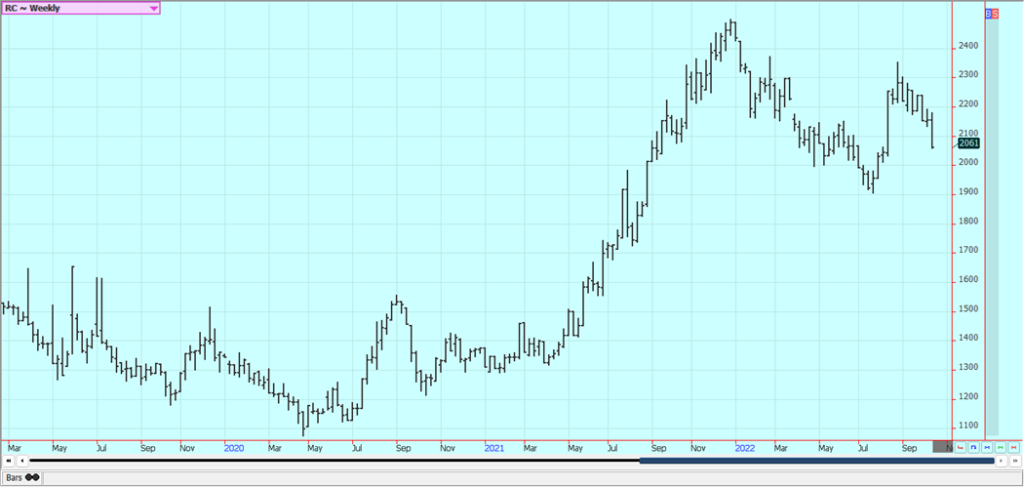
Sugar: New York and London closed higher last week with the market focused on what was happening in the outside markets and on the lack of supplies of White Sugar in the EU. Crude Oil was lower again after a strong rally last week based on news reports that OPEC and Russia would institute a production cut to keep prices elevated. Ethanol demand should increase and the pricing power of the mills can increase. The New York market had been worried that reduced ethanol demand due to taxing policies in Brazil will force mills down there to continue to produce more Sugar for export and Crude Oil futures have been weaker until recently. The Brazilian president has lowered the fuel taxes in Brazil, and this is squeezing the profit margins of the mills. The mills could produce much more Sugar over time due to the tax changes but so far have not produced enough to meet the demand. The London market had been looking for increased White Sugar supplies from origin as EU production was reduced by a hot and dry Summer. UNICA said that the center-south Sugar crush was 25.3 million tons for the second half of September, down 28.7% from last year.
Weekly New York World Raw Sugar Futures
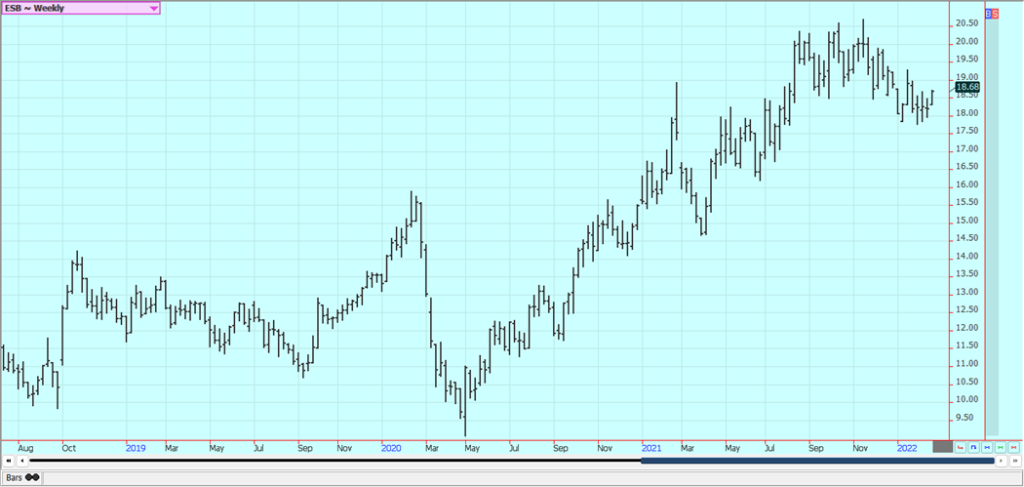
Weekly London White Sugar Futures
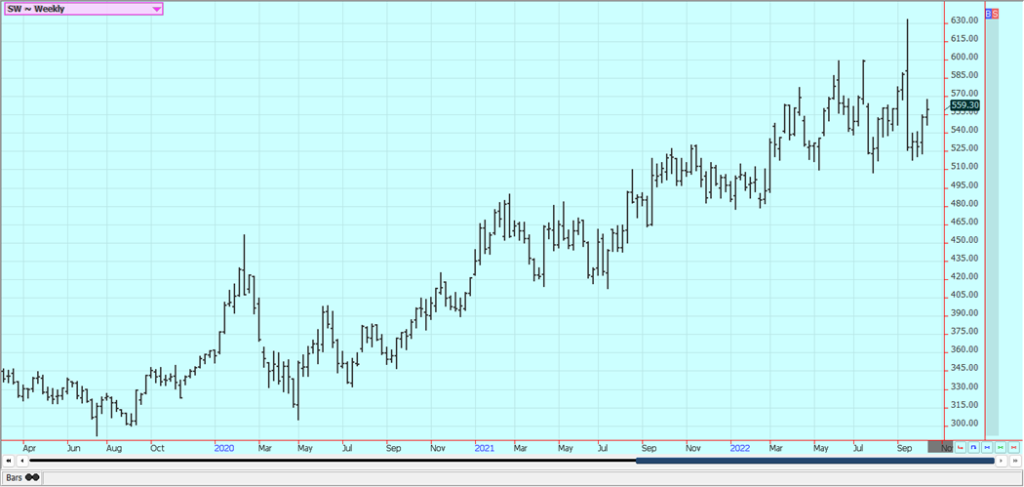
Cocoa: New York and London closed the week with moderate losses after trading much lower in the middle of the week. Prices are still relatively high given the fundamentals of good production and questionable demand. Ideas of big production and uncertain demand are still around but reports from Africa indicate that demand has improved lately. Reports indicate that buyers of Cocoa have enough coverage for now and can afford to wait for lower prices to develop. Supplies of Cocoa are as large as they will be now for the rest of the marketing year. Reports of scattered showers along with very good soil moisture from showers keep big production ideas alive in Ivory Coast. Ideas are still that good production is expected from West Africa for the year. The weather is good in West Africa. The weather is good in Southeast Asia. The EU grind was 369,679 tons for the third quarter, down 1.6% from last year.
Weekly New York Cocoa Futures
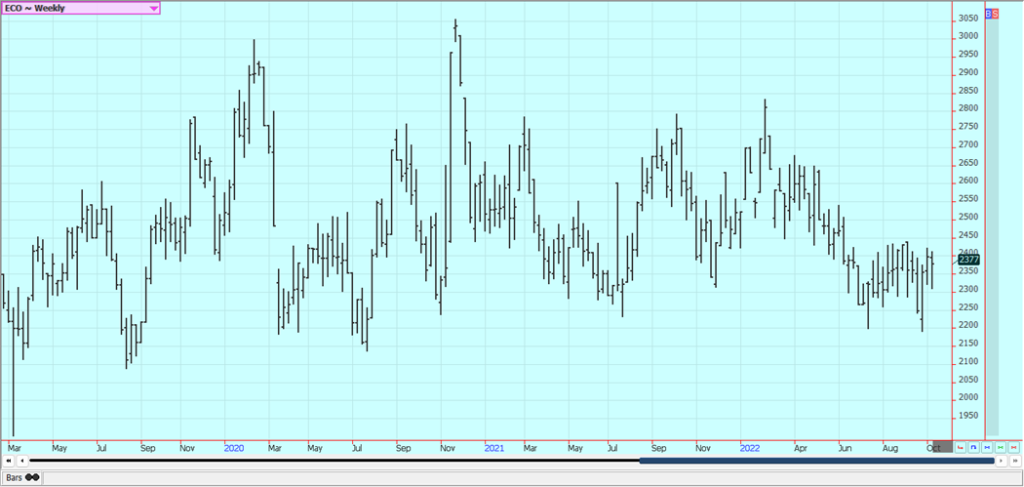
Weekly London Cocoa Futures

__
(Featured image by Alexandre Brondino via Unsplash)
This article may include forward-looking statements. These forward-looking statements generally are identified by the words “believe,” “project,” “estimate,” “become,” “plan,” “will,” and similar expressions. These forward-looking statements involve known and unknown risks as well as uncertainties, including those discussed in the following cautionary statements and elsewhere in this article and on this site. Although the Company may believe that its expectations are based on reasonable assumptions, the actual results that the Company may achieve may differ materially from any forward-looking statements, which reflect the opinions of the management of the Company only as of the date hereof. Additionally, please make sure to read these important disclosures.
Futures and options trading involves substantial risk of loss and may not be suitable for everyone. The valuation of futures and options may fluctuate and as a result, clients may lose more than their original investment. In no event should the content of this website be construed as an express or implied promise, guarantee, or implication by or from The PRICE Futures Group, Inc. that you will profit or that losses can or will be limited whatsoever. Past performance is not indicative of future results. Information provided on this report is intended solely for informative purpose and is obtained from sources believed to be reliable. No guarantee of any kind is implied or possible where projections of future conditions are attempted. The leverage created by trading on margin can work against you as well as for you, and losses can exceed your entire investment. Before opening an account and trading, you should seek advice from your advisors as appropriate to ensure that you understand the risks and can withstand the losses.

-

 Crowdfunding1 week ago
Crowdfunding1 week agoFrom Confiscation to Cooperation: Funding Casa de la PAZ’s Social Transformation
-

 Impact Investing2 weeks ago
Impact Investing2 weeks agoGlobal Energy Shift: Record $2.2 Trillion Invested in Green Transition in 2024
-

 Business2 days ago
Business2 days agoWhy the iGaming Industry Offers Some of the Best ROI for Affiliate Marketers
-

 Crowdfunding1 week ago
Crowdfunding1 week agoDolci Palmisano Issues Its First Minibond of the F&P “Rolling Short term” Program






